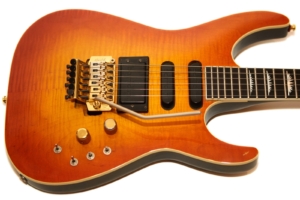
Introduction
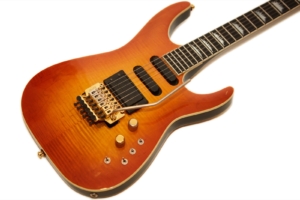
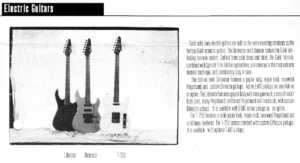

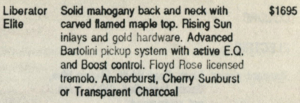
I’ve seen a bunch of posts online claiming that Guid only made nine of these, or that they only made a couple dozen. I asked Hans about that and his response was “a lot more than a dozen” were made so unless you read it from Hans’ next book, take any such claims with a grain of salt. They are definitely uncommon, but it’s not like there’s only nine of them.
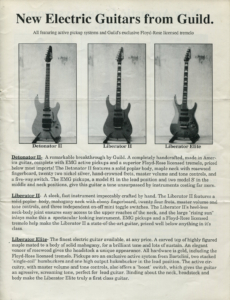
Notice in the tri-fold mailer (Thanks to Grot!) entitled “New Electric Guitars from Guild” it describes the Liberator Elite as “The finest electric guitar available, at any price.” I’ll be coming back to that bold statement a little later, so tuck that little bit of marketing hyperbole in your memory for a bit.
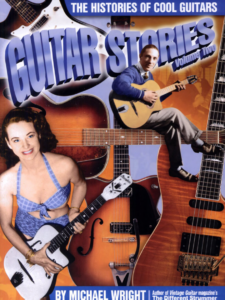
When it comes to accurate information on vintage Guilds, the only right answer is, “Help us Hans, you’re our only hope!”
Before I continue I need to point out that this is one of the longest reviews I’ve ever written and that’s largely because there is a lot going on with this guitar, all of which needs to be covered because as hard as I tried, I could not find any details about this model anywhere else out there. As always, I tore the guitar apart, documented every little detail and laid it all out for the world to see in this treatise comprised of just over 7,500 words which is almost twice my normal length for a review.
Finish
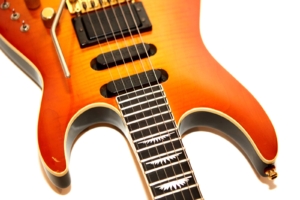
This guitar is a very nice amber burst which based on my research of Guild Nightbirds and other higher-end guitars by Guild, has to be one of their favorite finishes. According to the mailer shown above it came in Amber and Cherry Burst which makes me wonder which finish this one actually is. I’ve seen some that are far more red than mine, and Grot’s (which is known to be amber burst) is paler than mine, so I’m not sure if mine is faded cherry or dark amber. The best word to describe it is orange, so I think I’m going with amber. This guitar also came in a Transparent Charcoal finish which you can see in this youtube video.
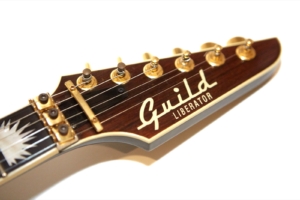
The headstock shape has a distinctive sort of “cake knife” look to it which I have to say I really like. It’s very distinctive and looks very rich with the rosewood veneer. By the way, if you don’t know what a cake knife is, don’t worry because apparently you’re not alone.
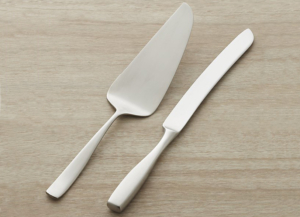
Fretboard and Neck
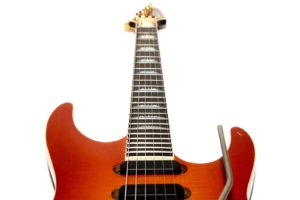
This is a 24-fret guitar so you can hit the highest of the weedly-weedly notes while abusing that Floyd Rose bridge in a manner unbefitting a gentleman, though this guitar was made in the late ’80s when bands like Poison and Mötley Crüe were not only wearing spandex but a liberal application of makeup, so I suppose the whole concept of gentlemen was rather in flux at the time.
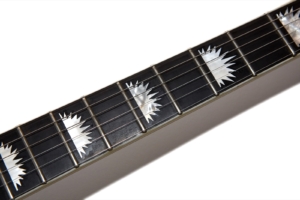
The frets measure at the typical .100″ wide by .03 high making them the same medium jumbos so common on Guild electric guitars. The width at the nut is 1 21/32″ which is halfway between 1 5/8″ and 1 11/16″. The fretboard radius measures at 20″ which makes it very flat, even for a super Strat. I rather like the neck as it reminds me of my favorite Jackson, though the Jackson is a bit wider. The fretboard looks and feels great and the frets are smooth and well finished though I think the neck has gone through some shrinkage or the frets need to be redone because I had some problems with strings catching that I’ll cover in the Playability section. Most super Strats I’ve played have big jumbo frets, but I’ve played so many Guilds over the years that I easily adapt and these don’t bother me at all. A hard-core shredder who is used to jumbos would likely think that these frets are too small.
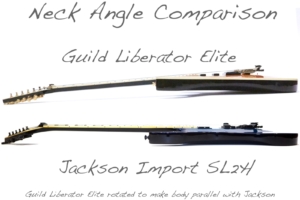
Now, a neck angle can be a good thing if your bridge is high, but in this case I think the bridge is high because of the neck angle and I can’t imagine why someone thought this was a good idea. My Guild S-281 from the mid ’80s has a pretty non-existant neck angle, though that’s got a Kahler bridge and a very flat top. My similarly equipped Guild S284 Aviator has maybe a 1° neck angle but it also has a Kahler. I think the combination of the Floyd Rose and the arched top just confused someone somewhere along the line during the design stage of the guitar.

Similarly, take a good look at the neck angle in that picture and imagine what would happen if the guitar were to fall backwards onto the floor. The headstock would hit first which I imagine would result in a very Gibson-esque headstock break so, if you own one of these rare beasts, don’t let that happen.
Build Quality
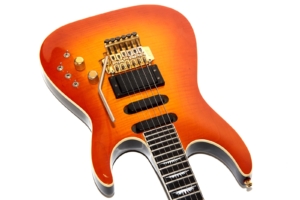
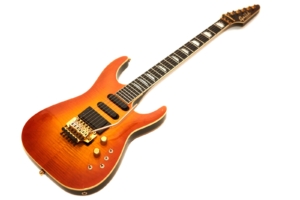
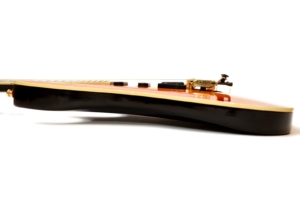
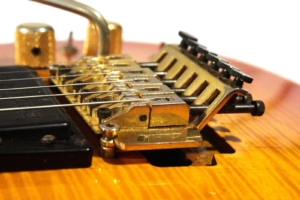
Talking about the bridge on this guitar gets me all worked up so let’s look at the pickups instead.
Pickups
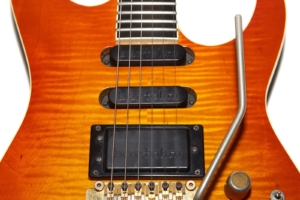
I emailed Bartolini and sent along these pics to see what they could tell me. My conversations with them indicated that the middle and bridge pickups are likely 3XV Fender Strat replacements while the bridge pickup is clearly the ECT-D that later got renamed to the E90-D. The E90-D is listed as “bridge – active dual coil (with E90 coils), high output + boost (9-volt operation only)” on their webpage.
There is not a whole lot of information out there about these pickups, but I did find a couple of documents while rooting though the Bartolini archives including the wiring diagram to the right which is very similar to the pickup wiring and layout in the Liberator Elite except that the Bartolini document clearly shows a normal Strat setup with three knobs and a 3-way rocker switch. These pickups, after all, were marketed as Strat replacements, so it makes sense that the technical documents of the time show a Strat-like layout.
The Bartolini 3XV pickups are “stacked single coils” which I assume means that they are two coils positioned one on top of the other as opposed to side by side like you would find in a traditional humbucker. The both have four connections and I’ll go over every gory detail of the wiring in this guitar in the next section.
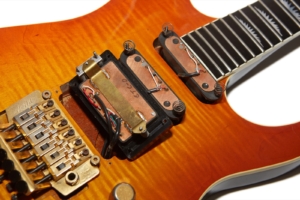
There were times during my testing where the pickups kind of hurt my head. I mean, they look like single coils and they sound like single coils but they behave like humbuckers and are wired like humbuckers. The fact that I can change the phase of what looks and often sounds like single coil pickups was too much for me to handle, but luckily this is a guitar that’s pretty fun to play so I channeled my angst into abusing the whammy bar with as much gain as possible which always seems to make me feel better.
Electronics
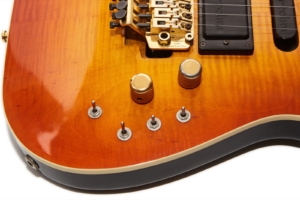
The additional switch which is all the way to the back and raised a bit from the other three is an active boost which is actually part of the bridge pickup and not a separate circuit (well, it is but it’s built into the bridge pickup’s housing).
Since the neck and middle pickups are Bartolini 3XV Strat replacements, they are actually humbucking pickups in single coil sized packages which means that each of them can have its phase switched, which is exactly what those two switches do. In theory they could be coil-split as well, but I’m kind of glad that they weren’t wired for that since I had enough to figure out with the guitar as it is. Each of the toggles are 3-position switches where up is one polarity (labeled (+) in my charts), down is the opposite polarity (labeled (-) in my charts) and the center position is the pickup completely off.
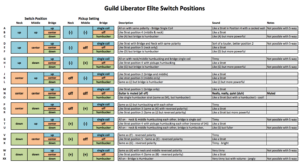
These three switches, each having three positions works out to a dizzying array of options. The math works out to 27 (3 x 3 x 3) possible options for the three switches alone. Add the ability for any of those positions to be normal or boosted with the fourth switch, and all of that combines to make a total of 54 different switch combinations. You read that right: fifty four possible combinations. Oh, and that chart with all the crazy combinations? That only shows the three switches and thus only shows 27 of them. Add the boost switch for 54 because 27 x 2 = 54 in case that’s too much math for you. Now look again and realize that the huge pile of tonal options shown in that table is only one half of those possibilities.
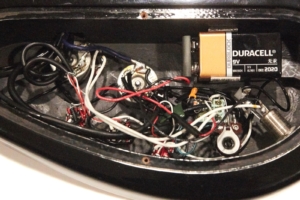
Tracing all of those wires and components was a full afternoon of fun since there is precious little documentation about this guitar out there and even getting information about the pickups was a challenge since two of them are not labeled and the one that is wasn’t even listed on Bartolini’s website.
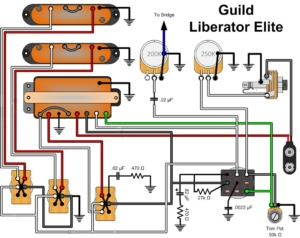
Inside the control cavity is a trim pot (visible as a white circle on the bottom right of the photo) which allows you to adjust how much increase the boost delivers. Another interesting thing about the boost is that when engaged, it applies to all pickups even if the bridge pickup is not in the mix. This is because all three pickups are in parallel and the boost has its own wiring scheme which is engaged with the fourth toggle. It’s really a very clever design.
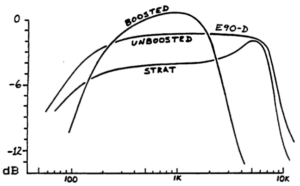
Note that some of the many switch variations produce the same results. For example with the neck and middle pickup switches both up, it sounds like a Strat in position 4. With those same two switches both down you get the same sound because you’ve reversed the phase of both pickups which nets the same result. Similarly, if you reverse the phase of one of them (up/down), you’ll get the same sound if you reverse the switches (down/up) because you’re producing the same result (out of phase pickup) but you’ve reversed both of them. As a result there aren’t truly 54 tonal options, but filtering out the duplicates was too much work for me to care about.
Hardware
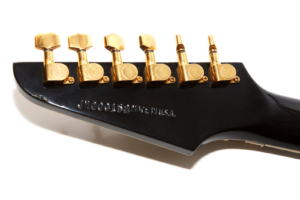
The knobs are at slightly odd angles because they were installed at a 90° angle to the top on an arched-top guitar. Most arch-top super-Strats have indentations in the top for the knobs so that they stick up straight. Not so here. The knobs are really a minor quibble, though, and the knobs themselves are nice enough.
This is a top-of-the-line high-end guitar that’s got class and style written all over it. This guitar could have put Guild on the map right smack dab in the middle of the Super-Strat revolution that was the ’80s and right at a point when Guild could have really used a winner. Sadly, Guild just never seemed to figure out that segment of the market, though they sure did try, and to be fair some of Guild’s other offerings of the time did do pretty well.
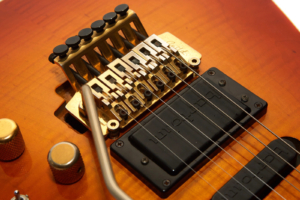
If you’re not familiar with shred guitars that have double-locking floating trems, they can do some wacky things. For example, when bending strings you’re putting more tension on the bridge and when the bridge floats, this can pull the guitar out of tune for the duration of the bend. If you wack on the arm of a free-floating trem, it will “flutter” which is an effect used by the likes of Steve Vai while he’s busy otherwise abusing his guitars. To “fix” this and other “issues” a Hipshot Tremsetter was installed at some point in this guitar’s past.
The Hipshot Tremsetter is not known as the best solution today where there are a myriad of other solutions, but there was a time where the Tremsetter was the only solution, and my guess is that it was during this time when it was installed. The Tremsetter makes the floating Floyd Rose feel kind of like a double swinging door in that there’s now a noticeable sort of detent in the resting position that’s not normally there. This detent (for lack of a better word) helps to keep the guitar in tune when bending strings and it reduces the tendency for the bridge to flutter when you don’t want it to. Long story short: I lubricated the crappy Tremsetter and the squeak went away, but it did not make me any happier about the bridge or its installation.
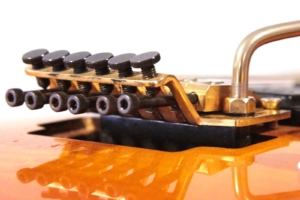
I rant and rave about the “import piece of crap” Floyd Rose, and that may by my ’80s guy bias showing. From what I can tell this is a Takauchi TRS-101 Licensed Floyd Rose which was made in Japan and is probably about the best of the import Licensed Floyd’s of the time. This model was pretty commonly used on import model guitars from Charvel, Washburn, Ibanez, Yamaha, and others. Hell, my Jackson SL2H is an import and likely has a Takeuchi Floyd Rose on it but it looks nicer because it’s finished and installed better. Way better.
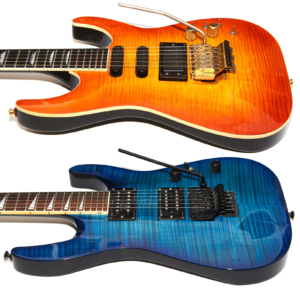
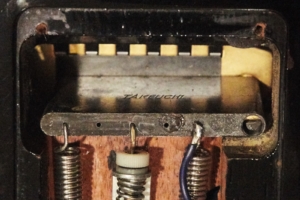
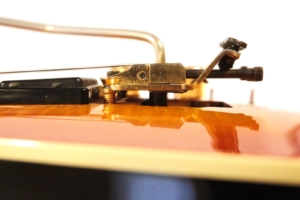
Let me make something absolutely clear, though: The bridge functions as it should. I’ve spent hours with this guitar doing dive bombs, flutters (barely), Dimebag squeals, the Mötley Crüe chopper sound, and the ol’ Satriani/Vai Lizard Down the Throat trick all without the guitar skipping a beat. The things I am complaining about regarding the bridge and its installation are, for the most part, cosmetic and not functional.
The guitar is built strangely, but it’s built well and plays well. Given the alternative of a guitar that looks great but plays like crap, I’ll take the Liberator Elite every time. Still, I’m here to give an honest review and honestly, the Floyd Rose looks like crap.
Sound
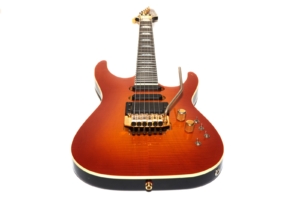
Actually, yes!
This guitar is so freaking versatile that I imagine the average guitarist setting maybe two or three killer tones and forgetting all the rest then swearing vehemently when anyone touches the switches.
This thing will go from the sweetest, chimiest straight-up Strat tones to the hardest of the 80’s metal hair band triple-rectrified shred metal with the flick of, well, of up to four switches depending on your previous setting. In fact, that’s one of the guitar’s downsides: it has so many tonal variations that remembering them all is a practical impossibility. Looking for a Dire Straights quack? Can do! Stevie Ray Vaughn? Sure thing. Mötley Crüe? Yup. Dokken? Yes. Humbucker neck tones a-la Gary Moore? Yes. Out of phase middle position humbucker Peter Greene tone? Sure. The problem is that in order to show you how I’ll need to grab my flowchart, and that actually brings me to my next dilemma.
Tiny Tweed
A-Barre: Normal
A-Barre: Boosted
Normally, when recording a guitar, I sample all of the possible tones with the knobs all on ten. In order to do that with this guitar I would need to record 54 samples on each amp setting. Ain’t nobody got time for that! Seriously, though, that’s a lot of options. So what did I do? I recorded them all, because that’s how nutty I am. Hey, if you came here to read about a Liberator Elite, then you probably want to know what all the damn switches do.
In a nutshell, this guitar sounds best to me either clean or with high-gain distortion. That great bluesy edge-of-breakup sound doesn’t seem to work too well on this guitar which my non-scientific gut is blaming on the pickups and maybe, just maybe, the poor installation of the bridge. People say that Bartolinis have a hi-fi sound and then usually argue for pages about what that means. Thinking about it, I think there’s not a lot of dynamics coupled with a very flat response curve which means they can sound compressed and uninspiring if you’re looking for traditional Les Paul or Stat tones.
While I think you can get a great variety of tones, you might have to work a bit for them. A case in point – imagine all of those tonal options I already talked about (54), and now add the variables of the tone and volume controls. Some of the settings sound better with the volume rolled back to eight. Some with the tone rolled to seven. Some with both rolled back. Holy crap that’s a lot to remember.

Oddly enough, that wide/flat curve makes them warm and chimey which is not usual in traditional guitar pickups and as we all know, if there’s one thing guitarists don’t embrace well it’s new ideas. Additionally, some of the pickup selection options just don’t sound good. If you don’t like the two humbuckers out of phase sound, then there are a number of tones in this guitar that you’ll just flat-out hate. Still, if you’re clever with amps and effects and modelers and such, then you may be able to invent some cool new tone, and that’s why I think people say they’re great for rack hounds.
JCM-800
Preamp Off
Preamp On
Brown Sound
Riff
Ain’t No Love
Tiny Tweed is no longer a patch on the new rig, so until I can recreate what I had, I just recorded using the stock JCM-800 patch and the Brown Sound patch which is designed to be pure ’80s Van Halen. Both of these recordings were done with the bridge pickup in humbucker mode and the boost turned on. The single coil pickups were off.
My normal selection of recordings is not here because a) the new Axe-FX doesn’t have a bunch of the patches I normally use and I didn’t move them over and b) the number of settings on the damn guitar had me stumped. What to record? My normal set of recordings would take me about six months to get through if I recorded all 54 possibilities! This entire article has been done for weeks and was just waiting on sound files so finally I just decided, “screw it”, sat down, plugged everything together and recorded whatever I felt like. If there’s something you’re dying to here let me know and I’ll see about recording it.
Playability
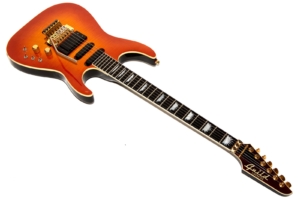
From a playability standpoint I don’t like how stiff the Floyd Rose is, but I can’t blame the guitar because I have no idea of it was originally like that.
Yes, the bridge is stupidly high, but I rest my picking hand on the bridge anyway, so my picking is not really affected by this. It is possible that the guitar my bother my wrist after long periods of playing since the bridge is so high, but having had two surgeries on my right arm due to nerve impingement problems, I’m pretty sensitive to those types of issues and usually notice them right away and I’ve played this guitar for over an hour without it bothering me. As a completely random comparison, I can’t use the track pad on a MacBook Pro for more than five minutes without my hand going numb.
It was another hour-long session where I noticed that the Floyd Rose itself was getting in my way when strumming. Because the bridge is so damn high I’ve found myself knocking my hand into it during some crazed strumming or maniacal picking. My right hand hit the row of fine tuners a couple of times which has never happened to me on any of my other Floyd-Rose equipped guitars, probably because they don’t stick up so high on my other guitars.
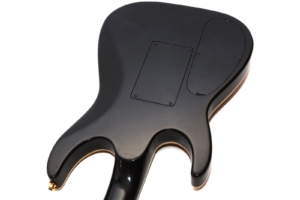
One thing that I didn’t expect to be a problem was quick changes of the pickup settings. On a Guild Bluesbird, for example, I slam the pickup selector and go to town because slamming a big pickup selector toggle is a gross motor skill that I can do mid-strum. Finessing four tiny toggles is a fine motor skill that makes me stop and look at the guitar so I can’t just do it without thinking. The good news is that all of the switches are well out of the way and behind the knobs so I don’t hit them while playing which is one of my biggest complaints with a traditional Strat.
My other complaint with normal Strats is that the middle pickup gets in my way when playing which is no doubt as a result of me playing a dual humbucker guitar for 20 years. That’s the reason that I like archtop super Strats – the arched top seems to solve that problem for me and I’m happy to report that this is mostly the case with the Liberator Elite as well.
Finally, this particular guitar has some fret issues because the high E string gets stuck under the fret ends during bending. Of course, this is an old guitar and may have suffered some shrinkage over the years and the frets likely need work, but I think the strings are just a touch to near the fretboard sides as I find myself slipping the low E string over the side from normal vibrato as well.
Conclusion
Normally my reviews of Guild guitars are maniacal fan-boy ravings and this one has a fair bit of ranting about things like neck angles and terribly installed import Floyd Rose systems. When it comes right down to it, though, I really dig this guitar, annoying design issues and all. I’m a guy that loves a Floyd Rose but the installation of the bridge on this guitar is just stupid. It does, however, work so I guess it could be worse.
Annoyances aside, this is guitar is a blast to play in part because its a high end instrument and in part because of the ridiculous number of tones that you can pull from the pickups. It’s also fun because the pickups are so unique.
Speaking of unique, this is not a guitar that you’re likely to see often. I mean, if you showed up to the battle of the bands with one of these slung over your shoulder, the likelihood of the competing band’s guitarist also having one is practically zero. The flip side of that equation is the fact that it might be hard to replace a pickup should one of them fail. Luckily we live in a world where eBay and Reverb exist to solve that problem.
This guitar doesn’t get the “OMG it’s a Guild go buy one!” award from me because, well I think you know why by now unless you skipped to the bottom in which case let me sum it up for you: the Floyd Rose installation is crap because of the severe neck angle but it plays fine anyway.
I think this is a guitar more suited to collectors than it is active players, and if you happen to be a collector that’s an active player, well then good luck finding one of these rare beasts unless you’re Grot, in which case you’ve already got one. Also, you can’t have mine. That’s the real review in a nutshell: It’s not perfect by any stretch, but I love it anyway.
If only Guild had managed to keep it together for a couple of years and come out with a Liberator Elite II. Man, what a guitar that might have been.
Donate: PayPal Crypto:
ETH: 0x0AC57f8e0A49dc06Ed4f7926d169342ec4FCd461
Doge: DFWpLqMr6QF67t4wRzvTtNd8UDwjGTQBGs

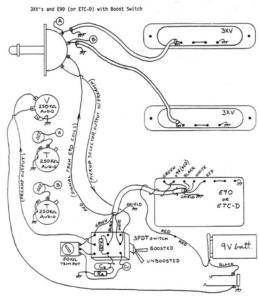
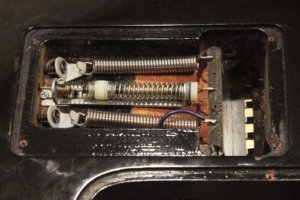


Thank you thank you thank you. I’m a guitar tech in Portland, OR and a client just brought me a Liberator Elite. First thing I noticed was that neck angle!!! And the electronics are a bit iffy but thanks to this amazing write-up, I know what they should do. Thanks again!
Let me get this straight…waaaa,waaaa,waaaa, bridge. Waaaa, waaa, neck angle. Waaa, waaa waaa, bridge. Beautiful! Waaa, waaa, waaaa bridge. Plays great! Sounds great! Waaa, waaaa, waaaa, bridge and neck angle. Great guitar!
Got it.
LOL. That sums it up nicely.
Great review, but I think I have an answer on the neck angle thingy. I once owned a i1987 Jackson Soloist with a similar neck to body angle. I also have a 1995 soloist with the modern zero angle set up. The 87 had the bridge so far above the body that it did not have the typical Flyod Rose top routing because it did not need it. The odd thing to me on your Guild is why the did the top routing at all, completely unneeded and sort of ugly to my eye. The
Part of the reason the term looks so high is the top routing. If it weren’t routed, it would look more normal I think. I loved my 87 Soloist back in the day, no limitations on the trem range of motion on pull ups, despite there being no top recess routing. So I think Guild added the recess to match other Floyd equipped guitars of the era without considering why the routing was needed. I bet it plays a lot like my old Soloist…
How yeah, my 87 Soloist had the 3 on/off switches too, pain in the neck.